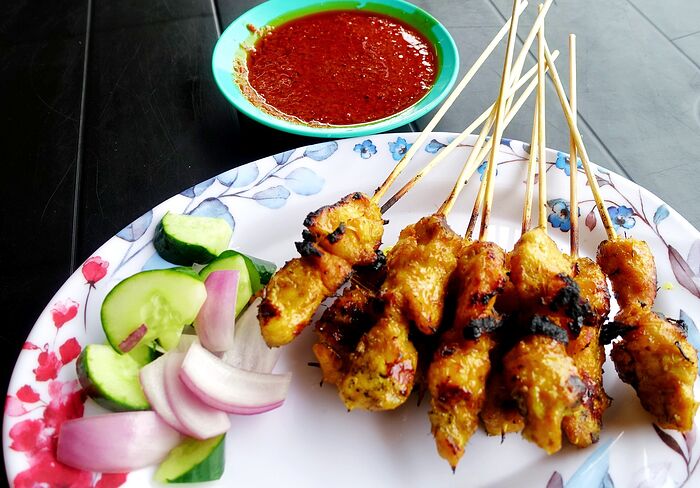Bukit Mertajam is a small town in Province Wellesley, Penang’s hinterland on mainland Malaysia, which is accessible from the island via the 8-mile-long Penang Bridge. In Malay, Bukit Mertajam means “Pointed Hill”, a reference to the highest point of the mountain range which is visible from Penang Island.
200 years ago, hardy Huizhou-Hakkas from Fujian, China, settled on the foothills of the 1,800-foot hill, and started farming the land. Hence, the Fujianese name for the town: “Tua Sua Ka” (Chinese: 大山腳), meaning “Foot of the Big Hill”.
But the area has been inhabited much longer than that – relics in the compound of St Anne’s Church, one of Bukit Mertajam’s major landmarks, showed Indian Pali inscriptions dating back to the 5th-century AD.
Today, Bukit Mertajam is well-known for the Feast of St Anne, an annual 10-day Roman Catholic festival which attracts upwards of 100,000 pilgrims each year.
But the biggest religious festival in Bukit Mertajam is the annual Taoist Hungry Ghost Festival, which culminates in a burning of the effigy of the King of Hades. The festival is observed throughout Chinese communities in East Asia, and the biggest one in Malaysia is actually held here, in this town.
But there was no religious festival last Sunday when we decided to make an excursion to Bukit Mertajam. In fact, we planned it that way since it’s never a good idea to visit Bukit Mertajam during a long weekend or festive season - the town’s narrow centuries-old streets would be jam-packed with cars, and the town’s cafes and eateries could hardly accommodate the crush of visitors and pilgrims.
Since 3 out of our party of 7 are Muslims, we chose to have lunch in a halal Malay restaurant: 𝗞𝗮𝗳𝗲 𝗕𝘂𝗱𝗮𝗸 𝗕𝗼𝘀𝘀, perhaps the best-known Muslim eatery near the old town centre.
I’d visited the town numerous times in the past few years, but never explored Malay-Muslim cuisine here before, so it was a great opportunity to do so.
“Budak” in Malay means “boy”, so I guess the youngish owner, Muhammad Amar bin Mustafa aka the “Boy Boss” must’ve started off managing his eatery at a very early age. He was actually busy grilling the satay skewers himself when we showed up for lunch there:
Nothing beats Malay 𝘀𝗮𝘁𝗮𝘆 grilled over open flames in a charcoal brazier
Malay-style chicken satay consisted of tender chicken meat which had been marinated in blend of spices: chilis, lemongrass, shallots, turmeric, ginger, galangal, and other aromatics. It’s good enough to eat on its own, even without its accompanying peanut sauce
The peanut sauce dip is a must-have for any satay meal. It’s made from coarsely-ground fried groundnuts, tamarind juice, sugar, and a spice blend which consisted of dried chilis, cumin, coriander, garlic, galangal & lemongrass.
Absolutely one of the best satays I’d had in recent times.
Another one of Budak Boy’s signature dishes is the grilled lamb chop (Malay: 𝗸𝗮𝗺𝗯𝗶𝗻𝗴 𝘀𝗮𝗹𝗮𝗶). It’s cut into strips, garnished with raw onions and cucumber, and served with a tamarind-based dip. Very well-done indeed - moist, tender, smoky lamb-meat.
𝗞𝘂𝗲𝘆 𝘁𝗶𝗮𝘂 𝗯𝗮𝘀𝗮𝗵 - this is a Malay version of the Chinese fried koay teow (flat rice noodle) dish. But whilst the Chinese version is wok-fried, the Malay version is braised, with copious amount of gravy which tasted very sweet. The main flavours in the dish came from the prawns and blood cockles, some blended chilis, onions and garlic, and a generous amount of sugar. It’s gluggy and (intentionally) messy on the plate. It was my first time having this dish, which I’d heard so much about.
Not really my kind of taste, but I’m very sure it’s got its fans:
𝗠𝗲𝗲 𝗴𝗼𝗿𝗲𝗻𝗴 𝗸𝗶𝗰𝗮𝗽 - another house specialty: this one’s fried noodles in a dark, sweet soy sauce. It’s very, and I do mean very sweet! It’s like eating fried noodles coated in molasses.
Ayam percik - flame-grilled chicken, marinated in galangal, shallots, ginger & coconut milk. This dish originated from the North-east state of Kelantan. Everyone else in Malaysia has copied the dish, but no one makes it as well as the Kelantanese. The one here, though it didn’t taste authentically Kelantanese, was very good in its own right: moist, juicy, smoky-aromatic chicken pieces which were positively bursting with delicious flavours.
Surprisingly, 3 in our party opted for the 𝗻𝗮𝘀𝗶 𝗰𝗮𝗺𝗽𝘂𝗿, basically steamed white rice, accompanied by one’s choice of side-dishes, which one can select from the cooked dishes displayed at the self-service counter:
Their choice of side-dishes included:
Daging masak hitam - blackened beef, which was beef strips braised in dark soy sauce and sugar, red chilis, shallots, onions, garlic & ginger
Fried eggs, blanketed in a sweet-sour tomato gravy
Fried tofu, with sweet chili sauce
Crisp batter-fried chicken
Long beans, cooked with chilis, onions, turmeric & egg
The cafe also offered its own range of 𝗱𝗮𝗱𝗶𝗵 𝗵𝗶𝗿𝘂𝗽 - Malay milk curd dessert, so-called as the pudding-like curd is soft enough to be consumed through a straw.
Address
Kafe Budak Boss
562A,Jalan Sungai Rambai, 14000 Bukit Mertajam, Penang, Malaysia
Tel: +6017-471 2085
Opening hours: 6am to 12 midnight

































